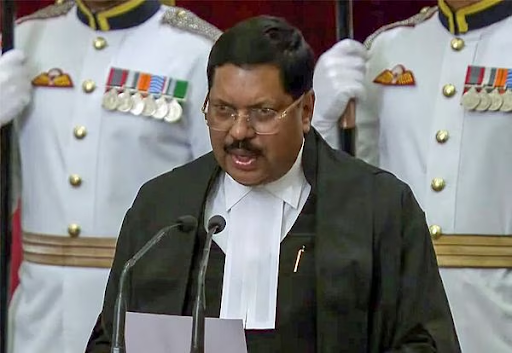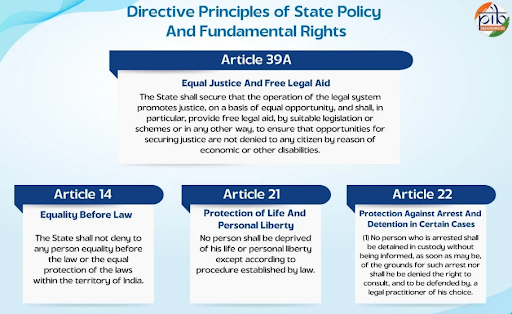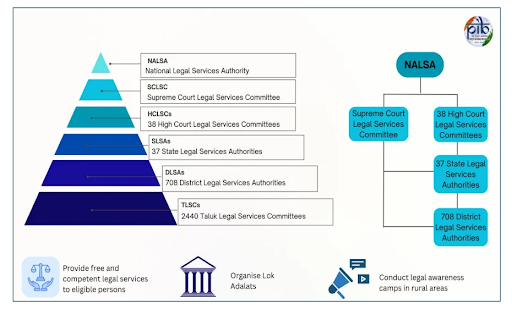



Legal aid upholds the constitutional promise of “justice for all” by offering free legal services to the marginalized. Through NALSA and state authorities, it narrows the gap between rich and poor, ensuring that financial or social disadvantages never restrict access to justice.

Copyright infringement not intended
Picture Courtesy: INDIANEXPRESS
The Chief Justice of India called legal aid a "moral duty" and vital for good governance, stressing its role in making the rule of law accessible to all citizens.
Legal aid is the provision of free or affordable legal services, including legal advice and representation in court, to individuals who cannot afford to pay for a lawyer.
Its primary purpose is to ensure equal access to justice and the right to a fair trial for all citizens, regardless of their economic or social disabilities.
Article 39A: Added by the 42nd Amendment, this Directive Principle of State Policy directs the State to provide free legal aid to ensure that justice is not denied to any citizen due to economic or other disabilities.
Article 14: Guarantees equality before the law, which is incomplete without ensuring equal access to justice.
Article 21: Protects the right to life and personal liberty. The Supreme Court has interpreted this to include the right to a fair trial, which necessitates access to competent legal representation.
Article 22(1): Grants every arrested person the right to be defended by a legal practitioner of their choice.

This Act provides the statutory framework for establishing a nationwide network to deliver free and competent legal services to the weaker sections of society.
The Act establishes a three-tier hierarchical structure to deliver legal aid:
|
Authority Level |
Name |
Headed By (Patron-in-Chief) |
|
National |
The Chief Justice of India |
|
|
State |
State Legal Services Authority (SLSA) |
The Chief Justice of the respective High Court |
|
District |
District Legal Services Authority (DLSA) |
The District Judge of the respective District |

Lok Adalats
It is an Alternative Dispute Resolution (ADR) mechanism established under the Legal Services Authorities Act, 1987. Binding Decisions: The award by a Lok Adalat is considered a civil court decree, is final, and cannot be appealed in other courts.
Focus on Amicable Settlement: It aims for compromise using a human-centric approach, rather than strict legal procedures.
Cost and Speed: Lok Adalats offer inexpensive and quick justice, with no court fees and a refund of fees for settled pending cases.
Voluntary Process: Cases proceed only if both parties agree to a settlement.
Composition: A bench includes a judicial officer and members like advocates or social workers.
Case Types: They handle various civil and compoundable criminal cases but exclude non-compoundable offenses.
Designing Innovative Solutions for Holistic Access to Justice (DISHA)
DISHA, implemented by the Department of Justice for 2021-2026, aims to advance justice for all through technology and awareness. Its key components include:
Other Supporting Institutions
|
Institution |
Purpose |
|
Legal Aid Defense Counsel System (LADCS) |
NALSA introduced this public defender-like system for free, timely, and quality legal defense in criminal cases. |
|
Fast-Track Courts (FTCs) |
To expedite trials of heinous crimes and long-pending civil cases. |
|
Fast-Track Special Courts (FTSCs) |
Established under a Centrally Sponsored Scheme to exclusively try cases of sexual offences, especially under the POCSO Act, 2012. |
|
Established under the Gram Nyayalayas Act, 2008, to provide speedy and affordable justice at the village level. |
|
|
Nari Adalats |
Part of Mission Shakti's 'Sambal' sub-scheme, these are women-only courts at the village level for alternative dispute resolution of domestic issues and gender-based violence. |
Lack of Awareness
Many eligible populations remain unaware of the existence of free legal aid services. Between April 2023 and March 2024, just 15.50 lakh people received legal aid services. (Source: NALSA)
Quality of Representation
Low remuneration for legal aid lawyers often leads to a lack of motivation and poor-quality services, diminishing client confidence.
As of March 2023, para-legal volunteers' daily honoraria: Kerala paid ₹750, 22 States paid ₹500, three paid ₹400, and Gujarat, Meghalaya, and Mizoram paid ₹250—barely covering basic daily expenses. (Source: NALSA)
Inadequate Funding
India's per capita spending on legal aid remains extremely low, though it has doubled from approximately ₹3 to ₹7 since 2019, affecting the quality and reach of services. (Source: NALSA)).
The budget for legal aid comprises less than 1% of the total justice budget (police, prisons, judiciary, and legal aid). (Source: NALSA)
NALSA's funds declined from ₹207 crore to ₹169 crore between 2017-18 and 2022-23, with utilization also dropping from 75% to 59%.
Weak Grassroots Integration
Coordination between DLSAs, para-legal volunteers (PLVs), local police, and community organizations is often inconsistent, limiting effective outreach.
Nationally, there is one legal service clinic for every 163 villages, as per the India Justice Report 2025.
The total number of para-legal volunteers dropped by nearly 38% between 2019 and 2024.
Societal Barriers
Fear of the police, social stigma, and distrust in state institutions prevent many, especially victims of domestic or caste-based violence, from seeking legal help
Enhance Funding
Increase the budget for legal aid to improve infrastructure and provide competitive remuneration to legal aid lawyers.
Strengthen Capacity Building:
Implement mandatory, specialized training for legal aid lawyers in areas like POCSO, cybercrime, and gender justice. Introduce performance-linked incentives.
Deepen Legal Literacy
Launch targeted awareness campaigns using local languages and media to reach marginalized communities effectively.
Empower Grassroots Network
Strengthen the Para-Legal Volunteer (PLV) scheme by providing better incentives and training, making them the first point of contact for justice delivery.
Adopt an Outcome-Oriented Approach
Shift focus from simply counting cases to measuring the quality of outcomes through user feedback, social audits, and impact assessments.
Improve Institutional Coordination
Encourage seamless collaboration between the judiciary, police, DLSAs, and civil society organizations to create a supportive ecosystem for justice seekers.
Legal aid is a fundamental constitutional right, crucial for equality and the rule of law. Despite a strong framework, challenges in funding, awareness, and service quality persist. Strategic reforms focusing on capacity, technology, and a people-centric approach are essential to achieve "Justice for All."
Source: INDIANEXPRESS
|
PRACTICE QUESTION Q. Evaluate the effectiveness of the National Legal Services Authority (NALSA) in translating the constitutional promise of free legal aid under Article 39A into a ground reality. 150 words |
Legal aid involves providing free and competent legal services, including legal advice, representation by a lawyer in court, preparation of legal documents, and payment of court fees, to those who cannot afford legal representation. It is available for both civil and criminal cases across all court levels (Taluk, District, High Court, and Supreme Court).
NALSA is a statutory body established under the Legal Services Authorities Act, 1987, to provide free legal services to the underprivileged and ensure justice is accessible to all citizens regardless of their economic or other challenges.
The Chief Justice of India serves as the Patron-in-Chief, while the second most senior judge of the Supreme Court is the Executive Chairman.








© 2025 iasgyan. All right reserved